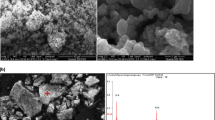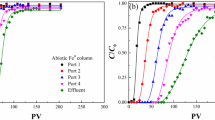Abstract
In order to assess the effects of phosphate, silicate and natural organic matter (NOM) on arsenic removal by ferric chloride, batch coprecipitation experiments were conducted over a wide pH range using synthetic hard and soft groundwaters, similar to those found in northern Vietnam. The efficiency of arsenic removal from synthetic groundwater by coprecipitation with FeCl3 was remarkably decreased by the effects of PO4 3−, SiO4 4− and NOM. The negative effects of SiO4 4− and NOM on arsenic removal were not as strong as that of PO4 3−. Combining PO4 3− and SiO4 4− increased the negative effects on both arsenite (As3+) and arsenate (As5+) removal. The introduction of NOM into the synthetic groundwater containing both PO4 3− and SiO4 4− markedly magnified the negative effects on arsenic removal. In contrast, both Ca2+ and Mg2+ substantially increased the removal of As3+ at pH 8–12 and the removal of As5+ over the entire pH range. In the presence of Ca2+ and Mg2+, the interaction of NOM with Fe was either removed or the arsenic binding to Fe−NOM colloidal associations and/or dissolved complexes were flocculated. Removal of arsenic using coprecipitation by FeCl3 could not sufficiently reduce arsenic contents in the groundwater (350 μg/L) to meet the WHO guideline for drinking water (10 μg/L), especially when the arsenic-rich groundwater also contains co-occurring solutes such as PO4 3−, SiO4 4− and NOM; therefore, other remediation processes, such as membrane technology, should be introduced or additionally applied after this coprecipitation process, to ensure the safety of drinking water.
Résumé
Afin d’évaluer les effets du phosphate, du silicate et de la matière organique naturelle (MON) sur l’élimination de l’arsenic par le chlorure ferrique, des expériences de co-précipitation en batch ont été menées sur une large gamme de pH en utilisant des eaux souterraines synthétiques dures et douces, similaires à celles trouvées dans le nord du Vietnam. L’efficacité de l’élimination de l’arsenic des eaux souterraines synthétiques par co-précipitation avec FeCl3 a été remarquablement diminuée par les effets de PO4 3−, SiO4 4− et MON. Les effets négatifs de SiO4 4− et MON sur l’élimination de l’arsenic n’étaient pas aussi forts que ceux du PO4 3−. La combinaison de PO4 3− et SiO4 4− a augmenté les effets négatifs sur l’élimination de l’arsénite (As3+) et de l’arséniate (As5+). L’introduction de MON dans les eaux souterraines synthétiques contenant à la fois PO4 3− et SiO4 4− a amplifié de façon marquée les effets négatifs sur l’élimination de l’arsenic. En revanche, Ca2+ et Mg2+ ont augmenté sensiblement l’élimination de As3+ à des pH compris entre 8 et 12 et l’élimination de As5+ sur toute la gamme de pH. En présence de Ca2+ et Mg2+, l’interaction de MON avec le Fe a été soit éliminée, soit la liaison de l’arsenic avec des associations colloïdales Fe-MON et/ou des complexes dissous ont floculés. L’élimination de l’arsenic en utilisant par la co-précipitation par FeCl3 n’a pas permis de réduire de manière suffisante les teneurs en arsenic dans les eaux souterraines (350 μg/L) pour répondre aux recommandations de l’OMS pour l’eau potable (10 μg/L), surtout lorsque l’eau souterraine riche en arsenic contient également des solutés tels que PO4 3−, SiO4 4− et MON. Par conséquent, d’autres processus de remédiation, tels que la technologie des membranes, doit être introduite ou ajouté après ce processus de co-précipitation, afin d’assurer la sécurité de l’eau potable.
Resumen
Para evaluar los efectos del fosfato, del silicato y de la materia orgánica natural (NOM) sobre la eliminación de arsénico por cloruro férrico, se realizaron experimentos de co-precipitación en batch en un amplio rango de pH utilizando aguas subterráneas sintéticas duras y blandas, similares a las encontradas en el norte de Vietnam. La eficacia de la eliminación del arsénico del agua subterránea sintética por co-precipitación con FeCl3 se redujo notablemente por los efectos de PO4 3−, SiO4 4− y NOM. Los efectos negativos de SiO4 4 y NOM sobre la eliminación de arsénico no fueron tan fuertes como la de PO4 3−. La combinación de PO4 3− y SiO4 4 aumentó los efectos negativos sobre la remoción de arsenito (As3+) y arsenato (As5+). La introducción de NOM en el agua subterránea sintética que contenía PO4 3− y SiO4 4− amplió notablemente los efectos negativos sobre la eliminación de arsénico. En contraste, tanto el Ca2+ como Mg2+ aumentaron sustancialmente la eliminación de As3+ a pH 8–12 y la eliminación de As5+ sobre todo el rango de pH. En presencia de Ca2+ y Mg2+, se eliminó la interacción de NOM con Fe o se floculó la unión de arsénico a asociaciones coloidales Fe−NOM y/o complejos disueltos. La eliminación del arsénico mediante la co-precipitación con FeCl3 no pudo reducir suficientemente el contenido de arsénico en las aguas subterráneas (350 μg/L) para cumplir con la directiva de la OMS para el agua potable (10 μg/L), especialmente cuando el agua subterránea rica en arsénico también contiene solutos coexistentes, tales como PO4 3−, SiO4 4− y NOM. Por lo tanto, otros procesos de remediación, como la tecnología de membranas, deben ser introducidos o aplicados adicionalmente después de este proceso de co-precipitación, para garantizar la seguridad del agua potable.
摘要
为了评价磷酸盐、硅酸盐 及天然有机物对利用氯化铁除砷的效应,利用类似于在越南北部发现的合成的硬地下水和软地下水在很宽的pH范围内进行了一批共沉淀实验。由于受到磷酸盐、硅酸盐及天然有机物的影响,与FeCl3共同沉淀除去合成地下水中的砷效能大大降低。硅酸盐及天然有机物对除砷的副作用不象磷酸盐的那么**烈。磷酸盐和硅酸盐组合增加了对除去亚砷酸盐和砷酸盐的副作用。引入天然有机物到含有磷酸盐和硅酸盐的地下水中大大放大了除砷的副作用。与此相反,Ca2+和 Mg2+大幅度增加了pH为8–12时除亚砷酸盐及整个pH范围内除砷酸盐的效果。在有Ca2+ 和 Mg2+的情况下,天然有机物与Fe的相互作用要么除去砷,要么砷凝固在Fe−天然有机物的交替上,及/或者溶解的复合物凝聚。用FeCl3共同沉淀除砷不能有效地降低地下水中的砷含量 (350 μg/L)以满足WHO的饮用水指南(10 μg/L),特别是在富砷地下水也含有共同出现的溶质诸如磷酸盐、硅酸盐 及天然有机物的情况下更是如此。因此,其他修复过程,如膜技术应当引进或者在共同沉淀过程之后应用膜技术以确保饮用水的安全。.
Resumo
Para de avaliar o efeito do fosfato, silicato e matéria orgânica natural (MON) na remoção de arsênio por cloreto férrico, as experiências de coprecipitação em lote foram conduzidas durante uma larga variação de pH, utilizando águas subterrâneas sintéticas moles e duras, similar aquelas encontradas no norte do Vietnã. A eficiência da remoção de arsênio das águas sintéticas por coprecipitação com FeCl3 foi notavelmente menor pelos efeitos do PO4 3−, SiO4 4− e MON. Os efeitos negativos da SiO4 4− e da NOM na remoção do arsênio não foram tão fortes quanto do PO4 3−. Combinando PO4 3− e SiO4 4−, aumentaram os efeitos negativos de remoção tanto no arsenito (As3+) quanto no arseniato (As5+). A introdução de MON nas águas subterrâneas sintéticas contendo PO4 3− e SiO4 4− acentuam significativamente o efeito negativo na remoção do arsênio. Em contraste, tanto Ca2+ quanto Mg2+ aumentaram significativamente a remoção de As3+ a pH 8–12 e a remoção de As5+ em toda variação de pH. Na presença de Ca2+ e Mg2+, a interação da MON com Fe foi removida, ou a ligação coloidal entre Fe-MON associada e/ou a complexos dissolvidos que foram floculados. A remoção de arsênio usando co-preciptação por FeCl3 não poderia reduzir suficientemente o conteúdo de arsênio nas águas subterrâneas (350 μg/L) para atingir o indicado pela OMS para águas potáveis (10 μg/L), especialmente quando a água subterrânea é rica em arsênio e também contém solutos co-ocorrentes, tais como PO4 3−, SiO4 4− e MON. Entretanto, outro processo de remediação, tal como tecnologia de membranas, deve ser introduzida ou adicionalmente aplicada após este processo de coprecipitação, para garantir a segurança da água potável.




Similar content being viewed by others
References
Dang MN, Nguyen KH, Changer B, Nguyen QH (2004) The adverse effects of arsenic on population health in selected communities of Ha Nam province. Workshop of Science and Technology Relating to Arsenic Contamination. Hanoi, Vietnam, 2004
Davis CC, Edwards M (2014) Coagulation with hydrolyzing metal salts: mechanisms and water quality impacts. Crit Rev Environ Sci Technol 44:303–347. doi:10.1080/10643389.2012.718947
Guan X, Ma J, Dong H, Li J (2009) Removal of arsenic from water: effect of calcium ions on As(III) removal in the KMnO4–Fe(II) process. Water Res 43:5119–5128. doi:10.1016/j.watres.2008.12.054
He QH, Leppard GG, Paige CR, Snodgrass WJ (1996) Transmission electron microscopy of a phosphate effect on the colloid structure of iron hydroxide. Water Res 30:1345–1352. doi:10.1016/0043-1354(95)00305-3
Hering JG, Chen PY, Wilkie JA, Elimelech M, Liang S (1996) Arsenic removal by ferric chloride. J Am Water Works Assoc 88:155–167
Kim KW, Chanpiwat P, Hanh HT, Phan K, Sthiannopkao S (2011) Arsenic geochemistry of groundwater in Southeast Asia. Front Med 5(4):420–433. doi:10.1007/s11684-011-0158-2
Liu RP, Li X, **a SJ, Yang YL, Wu RC, Li GB (2007) Calcium-enhanced ferric hydroxide co-precipitation of arsenic in the presence of silicate. Water Environ Res 79:2260–2264. doi:10.2175/106143007X199324
Lytle DA, Snoeyink VL (2002) Effect of ortho and polyphosphates on the properties of iron particles and suspensions. J AWWA 94:87–99
Mayer TD, Jarrell WM (2000) Phosphorus sorption during iron(II) oxidation in the presence of dissolved silica. Water Res 34:3949–3956. doi:10.1016/S0043-1354(00)00158-5
Meng XG, Bang SB, Korfiatis GP (2000) Effects of silicate, sulfate, and carbonate on arsenic removal by ferric chloride. Water Res 34:1255–1261. doi:10.1016/S0043-1354(99)00272-9
Meng X, Korfiatis GP, Bang S, Bang KW (2002) Combined effects of anions on arsenic removal by iron hydroxides. Toxicol Lett 133(1):103–111. doi:10.1016/S0378-4274(02)00080-2
Nguyen VA, Bang S, Viet PH, Kim KW (2009) Contamination of groundwater and risk assessment for arsenic exposure in Ha Nam province, Vietnam. Environ Int 35:466–472. doi:10.1016/j.envint.2008.07.014
Pullin MJ, Cabaniss SE (2003) The effects of pH, ionic strength, and iron-fulvic acid interactions on the kinetics of nonphotochemical iron transformations: I. Iron(II) oxidation and iron(III) colloid formation. Geochim Cosmochim Acta 67:4067–4077. doi:10.1016/S0016-7037(03)00366-1
Redman A, Macalady DL, Ahmann D (2003) Natural organic matter affects arsenic speciation and sorption onto hematite. Environ Sci Technol 36:2889–2896. doi:10.1021/es0112801
Ritter K, Aiken GR, Ranville JF, Bauer M, Macalady DL (2006) Evidence for the aquatic binding of arsenate by natural organic matter-suspended Fe(III). Environ Sci Technol 40:5380–5387. doi:10.1021/es0519334
Schmoll O, Howard G, Chilton I (2006) Protecting groundwater for health: managing the quality of drinking-water resources. IWA, London
Singh R, Singh S, Parihar P, Singh VP, Prasad SM (2015) Arsenic contamination, consequences and remediation techniques: a review. Ecotoxicol Environ Saf 112:247–270. doi:10.1016/j.ecoenv.2014.10.009
University of California (2003) Publication 8084: Groundwater quality and groundwater pollution. Retrieved from http://groundwater.ucdavis.edu/files/136273.pdf. Accessed October 29, 2016
USGS (2016) Water hardness and alkalinity. Retrieved from http://water.usgs.gov/owq/hardness-alkalinity.html. Accessed November 1, 2016
Vu KB, Kaminski MD, Nunez L (2003) Review of arsenic removal technologies for contaminated groundwaters. Retrieved from http://www.ipd.anl.gov/anlpubs/2003/05/46522.pdf Accessed May 7, 2016
Wilkie JA, Hering JG (1996) Adsorption of arsenic onto hydrous ferric oxide: effects of adsorbate/adsorbent ratios and co-occuring solutes. Colloids Surf A Physicochem Eng Asp 107:97–110. doi:10.1016/0927-7757(95)03368-8
World Bank (The water sanitation program) (2005) World Bank policy report: volume II technical report. Arsenic contamination of groundwater in South and East Asian countries. The International Bank for Reconstruction and Development, Washington, DC
Acknowledgements
This study was supported by the International Environmental Research Center (IERC) and the UNU & GIST Joint Programme on Science and Technology for Sustainability, Gwangju Institute of Science and Technology (GIST) in the Republic of Korea.
Author information
Authors and Affiliations
Corresponding author
Additional information
Published in the special issue “Hydrogeology and Human Health”
Rights and permissions
About this article
Cite this article
Chanpiwat, P., Hanh, H.T., Bang, S. et al. Single and combined effects of phosphate, silicate, and natural organic matter on arsenic removal from soft and hard groundwater using ferric chloride. Hydrogeol J 25, 1183–1190 (2017). https://doi.org/10.1007/s10040-016-1524-6
Received:
Accepted:
Published:
Issue Date:
DOI: https://doi.org/10.1007/s10040-016-1524-6




